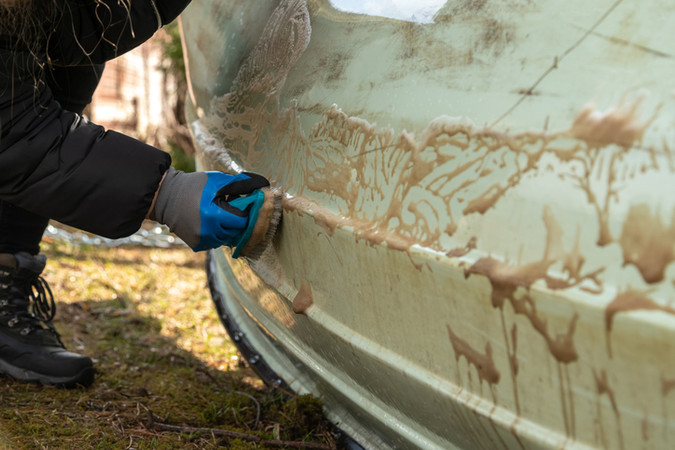Restoring Your Boat’s Gelcoat
Posted by Flitz International on 11th Mar 2022
If your boat has seen more than a couple of seasons of sun and water, you’ve probably experienced that awful feeling as you’re pulling her out of storage to find that she’s not the belle of the ball she once was. Sun and salt, even fresh water, takes its toll on your boat’s hull. That once shiny fiberglass has started to become faded, stained and chalky.
You’re not alone. Everyone’s gelcoat stains and oxidizes over time. So how do you give her the facelift she so desperately needs?
Restoring that gelcoat is actually pretty simple provided there’s still gelcoat covering your fiberglass. The chalking. Staining and dulling you’re seeing is typically only affecting an ultra-thin top portion of the gelcoat and with a little cleaning and polishing you can bring back that showroom shine.
Start With The Wash
Your best bet is always a good marine soap to start the process. While you can use most any dish soap, you’ll find that marine soaps are effective and a lot more environmentally friendly. A good stiff brush and a garden hose and you’re on your way! Start with a manageable section and move on to the next one when that once if finished. Most folks try to do a whole side at once and that just never works out well.
Don’t be discouraged if all the staining and chalkiness doesn’t come right off. This initial hull wash is designed to get rid of the surface dirt, grime and algae. That layer of oxidation is the target of our next step.
Restoring The Gelcoat
Here you’re going to need a few things; a great polish, a great buffer, a corded or cordless drill, shop towels and a number of thick ‘n thirsty microfiber towels.
The Polish: Admittedly we’re biased, but for all the right reasons. Flitz Paste Polish is unsurpassed at removing that layer of stained oxidation and leaving behind a brilliant shine with a protective wax coating. Depending on the size of your boat a two-pound can will do you nicely and you’ll have some left over for shining up the brightwork topside.
The Buffer: While an orbital buffer is a good bet, avoid the strap on bonnets made for sanders. At too high a speed, the buffer will heat up and you’ll run the risk of scorching and/or burning through your gelcoat. To eliminate that worry, we strongly suggest using one or more of our patented Buff Balls. Buff Balls are designed with self-cooling fingers that actually bring air to the surface, eliminating the danger of overheating. Best of all, they’re designed to fit into that 3/8” drill you already have. If you have extra batteries, great. If not, we recommend using a corded drill. You’ll get higher RPMs and better results than with a cordless.
The Process
Apply a thin coat of Flitz Polish to a small section of the hull. (You don’t need a lot) Spread the polish around with the edge of the Buff Ball before you begin buffing to avoid a lot of splattering. When you do finally pull the trigger, start slowly to spread the polish around and then gradually ramp up the speed to let the polish do its thing.
Almost immediately you’ll see the stains and black oxide come off onto the Buff Ball. That’s normal and that’s what you want to have happen. In fact, the more polish that gets onto the Buff Ball, the better it works over time. Don’t worry about all that black oxidation. Your Buff Ball is washable and reusable! Getting good results will take a little time, which is why you want to do small sections to keep the project manageable.
If you’re faced with heavy staining or you’re restoring an older boat, a second or third application of polish may be necessary. Flitz Paste Polish is technically non-abrasive, so two or three applications will not harm your gelcoat. Take your time, work small sections and enjoy the process.
Finishing The Job
- Once you’ve finished the hull, here are some things to consider:
- The Buff Ball will deliver a good shine, but a final had buff with a clean microfiber real brings out the luster.
- Flitz Polish leaves behind a thin layer of beeswax on your gelcoat which will protect it for two to three months.
- For additional protection, consider applying our Flitz Ceramic Sealant over the hull. It’s an easy spray and wipe application and will provide nano-ceramic protection for up to six months even in salt water!
- The extra polish you have left over will clean, polish and protect all your brightwork, eisenglass, acrylic hatch covers, props and even your galley fixtures. It’s a great value!


